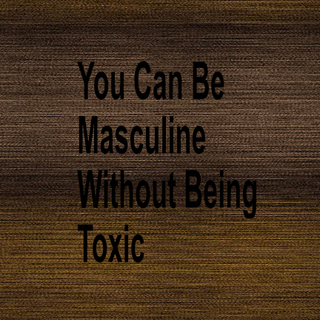Embarrassment
Why Masculinity Doesn't Have to Be Toxic
Toxic masculinity is a constricted version of manhood that has many perils.
Posted April 30, 2022 Reviewed by Tyler Woods
Key points
- Toxic masculinity is not a criticism of masculinity.
- Toxic masculinity might entail being aggressive rather than assertive, controlling rather than in control and dominating rather than competitive.
- Toxic masculinity is one resolution for dealing with shame, an attempt to preserve a positive self-image.
- Conforming to rigid norms of masculinity has often been linked to alcohol and substance use, risk-taking behavior, violence, and depression.
The Good Men Project defines “toxic masculinity” as follows:
Toxic masculinity is a narrow and repressive description of manhood, designating manhood as defined by violence, sex, status and aggression. It’s the cultural ideal of manliness, where strength is everything while emotions are weakness where sex and brutality are yardsticks by which men are measured, while supposedly “feminine” traits–which can range from emotional vulnerability to simply not being hypersexual–are the means by which your status as a [real] “man” can be taken away.

It is not a criticism of masculinity but rather a constricted version of masculinity. The traditional view holds that men are assertive, in control, powerful and courageous, and competitive. By contrast, toxic masculinity might entail being aggressive rather than assertive, controlling rather than in control, risk-taking rather than courageous, and dominating rather than competitive. Toxic masculinity entails an intense need and desire for power that may fuel the assertion of that power over others—in the form of misogyny, racism, and homophobia.
Toxic masculinity is a narrowly defined way of being a man, one that can undermine genuine connection, empathy, and compassion. The term “toxic masculinity” covers a broad range of attitudes and behaviors, which may or may not all be present in one individual. Specifically, some men may exhibit one, a few, or many of the characteristics that define it.
Contributions to toxic masculinity
The experience of shame is at the core of disowning parts of oneself. Additionally, it is often the impetus for compulsive perfectionism. Toxic masculinity is one resolution for dealing with shame, an attempt to preserve a positive self-image. According to researcher and psychologist, Brené Brown, any weakness is seen as shameful (Hinds, 2013). Since even vulnerability is seen as weakness, it, too, is to be avoided.
These attitudes support internal conflict and a heightened sensitivity to avoid a broad variety of experiences. These might include feelings, thoughts, or behaviors, as well as appearances, physical mannerisms, clothing, crying, empathy, and even spontaneous play–which might be perceived as being less than manly.
Toxic attitudes may be encouraged in childhood when young boys receive messages such as, “Boys don’t cry!” “Be a man!” or, “Don’t act like a girl.” Through other messages that are explicit, as well as those that are implied or modeled, a boy learns what it means to be a man. Consequently, a child may soon experience cognitive dissonance with certain attitudes, feelings, and behaviors that he feels compelled to reject. “Man up” is the adult version of these message with the same intent, that feelings—and especially suffering—should be avoided, as they are a sign of weakness.
We innately have a desire to be connected with others and to obtain approval and acceptance. However, the need to belong and to obtain approval can undermine and compete with living a life that is consistent with our core values and unique self. Shame informs us that who we are is not good enough.
And yet, inner peace comes from integrating all aspects of ourselves. It means accepting our full humanity, that we have feelings, weaknesses, faults, and failures. It entails full acceptance that there is great variation in the ways we could be masculine or feminine. It calls for remembering that even these terms can be experienced as constrictive in expectations associated with them.
Toxic masculinity, for some, has been viewed as being influenced by a threat to one's masculinity. Some view it as a reaction to experienced humiliation as a result of the women’s movement. In fact, the American Psychology Association reports that men react more strongly to shaming by women than by other men (2018). Additionally, some view toxic masculinity as a response to humiliation related to the loss of job opportunities, financial pressures, and feeling discounted by other groups. Certainly, toxic masculinity may be impacted by all forms of mass media as well as by social pressures defined and practiced within one’s culture.
Toxic masculinity has also been associated with autocratic government, and the desire to maintain allegiance to an autocratic leader who provides validation of such masculinity, reduces choice, promises to address their suffering, and can provide a sense of belonging to an empowered group. This same preference can be a powerful driving force for some women, as it might mirror earlier experiences with certain men as well as echo longings to be taken care of by a male figure.
The cost of toxic masculinity
All too often the price paid by adhering to toxic masculinity is a sense of emotional isolation, a constriction in identity that fosters irritability, frustration, and anger. As an anger management specialist, I’ve witnessed the cost of toxic masculinity—evidenced by stories of physical aggression whether on the road or in relationships. I’ve also heard of how alcohol or substance abuse, volatility in relationships, and difficulties in the workplace can be influenced by toxic masculinity.
Some of these men evidenced self-reflection and recognized the pressures and related depression due to living up to such rigid expectations of themselves. This awareness is crucial to change. Unfortunately, all too often, those with issues related to toxic masculinity avoid seeking help. In fact, most of the men who came to counseling for these issues were referred by someone else—by work supervisors, professional organizations, the courts, or sometimes a partner threatening to leave them.
Conformity to dominant masculine norms, especially when rigid, has often been linked to negative behaviors among young adult men, such as problematic alcohol use, violence, and risky sexual behavior. Toxic masculinity may contribute to: bullying, challenges at school or work, substance abuse, domestic violence, and even jail or prison time. Additionally, based on a study of 1,100 males aged 14 to 21, toxic masculinity has been found to inhibit young men from seeking mental health even when they report difficulties associated with anxiety, depression, or low mood (Stem4, 2021).
It should also be noted that higher levels of self-compassion are related to lower masculine norm adherence, lower trait shame, and higher self-esteem (Reilly, et. al., 2013). Further, a study of 545 males, with an average age of almost 39, indicated that responses to an assessment endorsing higher levels of masculinity significantly predicted depression symptoms, especially when they also reported higher levels of shame (Rice, 2016).
Healthy emotional and psychological well-being very much depends on our accepting and integrating all aspects of being human. This supports our having greater ease, resilience, and fulfillment in our relationships with others and ourselves.
It’s important for adult men, and especially young men, to develop a sense of identity based on open self-reflection and awareness that supports emotional and psychological flexibility. This allows for real freedom of choice in creating one’s identity and having the resilience to deal with life’s challenges. Young men can choose to include variations of being masculine that do not include toxicity, living a life defined by rigid expectations of how one “should be.”
References
O’Malley, H. (2018) What is toxic masculinity? The Good Men Project: https://goodmenproject.com/featured-content/what-is-toxic-masculinity-c…
Hinds, A. (2013) Messages of shame are organized around gender. The Atlantic.https://www.theatlantic.com/sexes/archive/2013/04/messages-of-shame-are…
American Psychological Association, Boys and Men Guidelines Group. (2018). APA guidelines for psychological practice with boys and men. Retrieved from http://www.apa.org/about/policy/psychological-practice-boys-men-guideli…
Stem4 (2021) Toxic masculinity is stopping boys seeking mental health support: https://stem4.org.uk/wp-content/uploads/2021/11/Toxic-masculinity-stopp…
Reilly, E., Rochlen, A., & Awad, G. (2013, February 18). Men's Self-Compassion and Self-Esteem: The Moderating Roles of Shame and Masculine Norm Adherence. Psychology of Men & Masculinity. Advance online publication. doi: 10.1037/a0031028
Rice, S., Aucote, H., Moller-Leimk¨hler, A. (2016) Conformity to masculine norms and the mediating role of internalized shame on men’s depression: Findings from an Australian community sample. International Journal of Men’s Health, 15(2): 157-164.




